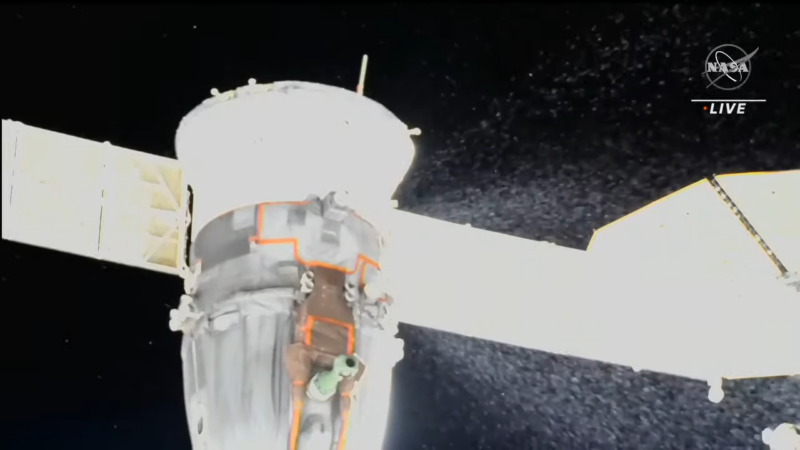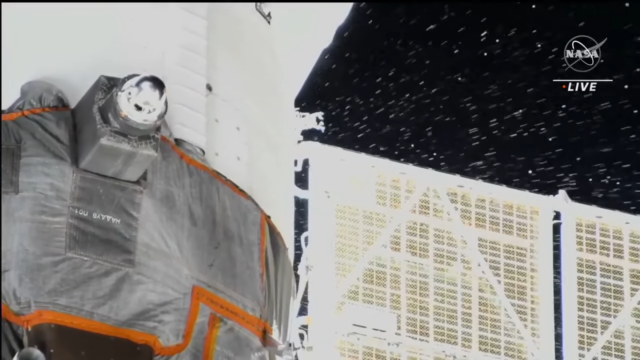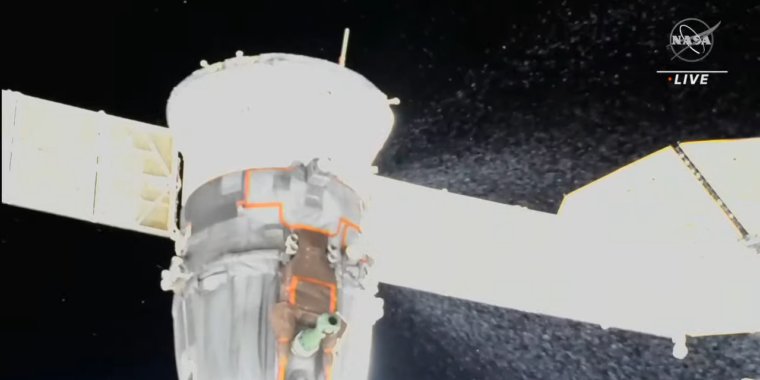
NASA TV
A Russian spacewalk was canceled at the last minute Wednesday evening when a spacecraft docked to the International Space Station unexpectedly caused a major leak.
Cosmonauts Sergey Prokopyev and Dmitri Petelin were dressed in spacesuits, with the airlock depressurized, when flight controllers told them to stand by while the leak was investigated in a Soyuz spacecraft. The spacewalk was then called off shortly before 10 p.m. ET (Thursday 03:00 UTC).
The leak appears to have originated in an external cooling loop on the back of the Soyuz MS-22 spacecraft. Public affairs officer Rob Navias, commenting on the spacewalk for NASA Television, characterized the spacecraft as having a “fairly substantial” leak. Video of the leak showed particles continuously pouring out of the Soyuz, a rather remarkable sight. This was likely ammonia, which is used as a spacecraft coolant, though Russian officials have not confirmed this.
At no time was any of the crew on the space station in danger, including Prokopyev and Petelin, their fellow cosmonaut Anna Kikina; NASA astronauts Frank Rubio, Nicole Mann, and Josh Cassada; and Japanese astronaut Koichi Wakata. The leak was outside the station, not in the orbiting lab.
However, the leak raises questions about the viability of the Soyuz spacecraft, the ride back to Earth for NASA’s Prokopyev, Petelin and Frank Rubio. They launched to the space station in September aboard this Soyuz vehicle and will return to Earth next spring. After three hours Monday night, the leak persisted and showed no sign of abating.
The Soyuz is a strong spacecraft, so it is likely that there will be no impact whatsoever on its ability to detach from the space station and return to Earth. However, if Russian engineers — and those at NASA, who assume Rubio will be on board — determine there’s a problem, a replacement Soyuz should be flown to the station. Soyuz vehicles have the ability to launch and dock autonomously. However, it would mean that until the replacement spacecraft arrives, the three crew members would not have an emergency escape vehicle.

NASA TV
The other four astronauts aboard the station flew on a SpaceX Crew Dragon spacecraft in October. That vehicle cannot accommodate seven people for a return to Earth.
Given the long duration of the leak, NASA will probably also be concerned about the impact of all that ammonia on the surfaces of the space station and those of other docked vehicles. Much of the ammonia would likely boil off the surface of the hardware over time, but it will certainly complicate operations as the US space agency plans its own spacewalk on Dec. 19 to install new solar panels.

